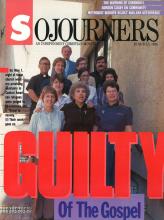During the long, exasperating, painful experience of the Tucson sanctuary trial, several sanctuary workers found themselves turning to their Salvadoran and Guatemalan brothers and sisters—the very refugees they were on trial for helping—for advice and comfort. "How did you react when you were unjustly treated?" they would ask the refugees, who had endured torture, imprisonment, death threats, and the killing of family members. "Were you able to love your enemies, your torturers? It is so hard," the sanctuary defendants would confess to the refugees. Then they would cry together, pray together.
It was as if the suffering and the compassion had, through the trial, come full circle. One refugee, while testifying on the witness stand, was asked to implicate the woman who had helped him. Pointing to 26-year-old defendant Wendy LeWin, he said, "Yes. I remember her with much love."
Out of their common suffering, their common sacrifice, and their common love and respect for one another, both refugees and sanctuary workers found new life, new hope, and new strength for the struggle—even as the sanctuary workers faced possible prison sentences and the refugees faced probable deportation to certain violence and danger in their homelands.
It is such spiritual bonding between North American sanctuary workers and Central American refugees that U.S. government prosecutor Donald M. Reno Jr., who throughout the long trial continued to refer to it as a "simple alien-smuggling case," failed to understand. And it was that quintessential failure, the government's refusal to acknowledge and its inability to grasp the spiritual foundation and glue of the sanctuary movement, that caused its extraordinary attempt to squash the movement not only to fail but to backfire.
Read the Full Article
